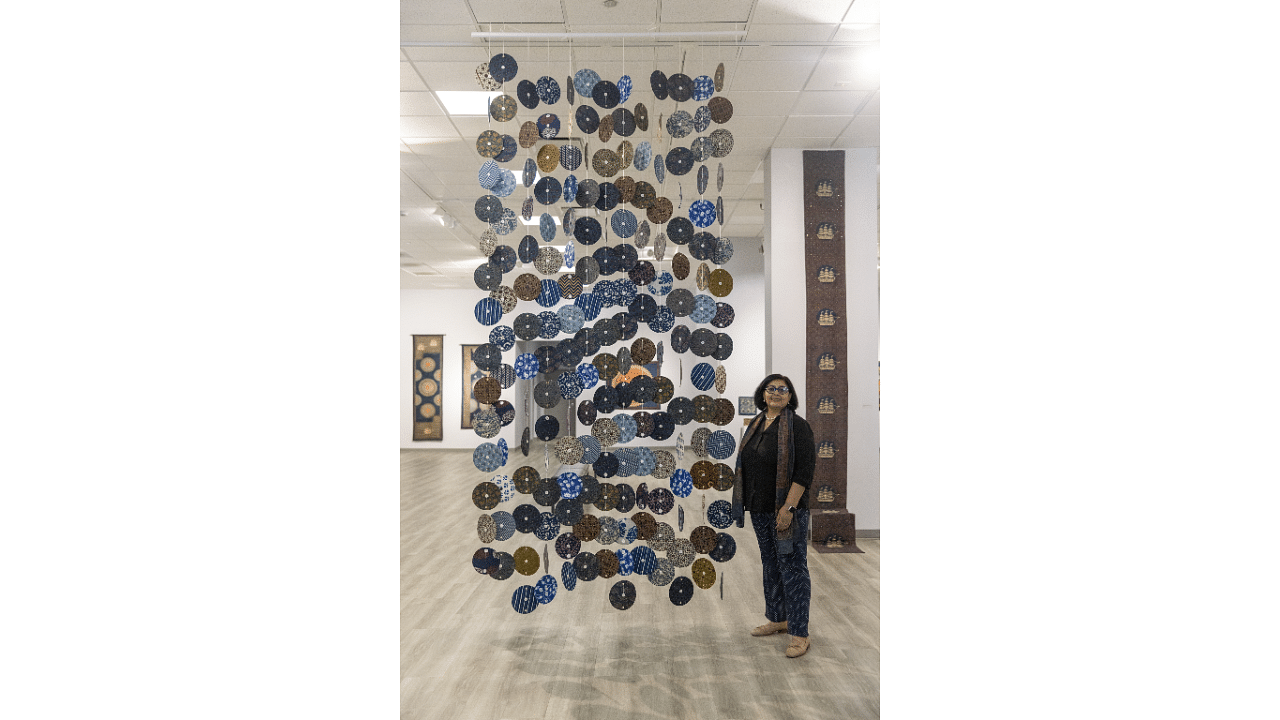
One of the works at the exhibition.
Photo Credit: Pratyush Swarup
Renowned artist Shelly Jyoti’s latest art show Indigo-The Blue Gold, A Captivating Exploration of Indigo Dyeing Traditions and Colonial Trade is on at the South Asia Institute, Chicago. The exhibition is her mid-career retrospective from 2009-23, consisting of over 40 selected artworks, three site-specific installations, multimedia poetry performances and two documentaries. Through Indigo, Jyoti seeks to engage viewers with the complexities of indigo's history and its relevance in the present day. “This cherished and seemingly innocuous dye has had a profound impact on our modern lives, and it is crucial to understand the darker chapters of its past to nurture a more sustainable and compassionate future,” she explained.
Laura Kina, the show’s curator and Vincent de Paul Professor, The Art School, DePaul University, said, “The exhibition deftly mixes a poetic narrative memorialising the 1859 Indigo Revolt and the farmers of Champaran with textile works that use the iconography of ships, globes, Gandhi’s spinning wheel, fish and indigo plants to trace India’s colonial history of British indigo plantations, trade, forced labour and the resulting migration.”
With the exhibition, Jyoti delves deeper into the historical significance of indigo dye as a transnational and exploitative commodity that connected the world through profitable trade, migration streams, slavery and colonisation. Needless to say, the impact of capitalism on the indigo industry spans several centuries, and its consequences for those involved have been profound. Through her work, she sheds light on the untold stories of indigo slaves in South Carolina, exploited farmers in Eastern India and indentured labourers who endured great hardships while cultivating indigo in the Caribbean.
Previously, Jyoti collaborated with Kina in an earlier work called Indigo Narratives. “I explored socio-political narratives inspired by the 19th-century indigo revolt in Eastern India, known as neel bidroh,” she says. The exploration of this historical event provided a cross-cultural lens to examine the exploitative nature of the indigo trade and its far-reaching effects and Mahatma Gandhi’s intervention in Champaran in 1917-18. “His efforts on behalf of exploited indigo cultivators became a significant experiment in nonviolence during India's freedom struggle,” she said.
Beyond historical narratives, Jyoti is captivated by the possibilities of indigo as a plant colour and dye. Her passion for traditional Indian textiles propelled her to explore the rich traditions of ajrakh, a 4,500-year reverse block printing technique used for functional fabrics, further connecting the past with contemporary practices. For this, she collaborated with the ninth or tenth generation of Ajrakh artisans who migrated from Sindh and Balochistan in 1600 CE and continued with ancient textile traditions of printing and dyeing in Bhuj, Gujarat. She utilised the technique using natural dyes, creating artwork on hand-spun khadi and narrating her stories visually. “Invoking such traditions, I bring together khadi as a fabric, Ajrakh textile traditions and the skill of the craftspeople, while giving my own interpretation in a visual form. Working with various media and excavating from history, my art celebrates the subaltern,” she said.
Jyoti derives inspiration from Gandhi’s ideology of nation-building centred on moral and peaceful societies. She channels these principles into her work by infusing them with themes of Swadharma, Sarvodaya, Swadeshi, Swaraj and Svavlambhan. “In essence, my art becomes a canvas for translating Gandhi's ideals into visual narratives, fostering moral reflection, peaceful coexistence, sustainable progress and collective consciousness,” she says.
Recently, Jyoti also unveiled her collection called 'Charkha: The Wheels of Swavalamban' at the Shilp Deergha Gallery at the new Parliament building in Delhi. A triptych artwork that embodies responsibility to self, community and country, it is a visual ode to India's freedom struggle. The works in it, encapsulating history, creativity and duty serve as a powerful reminder of our quest for self-reliance and the legacy of sacrifice. “The charkha's symbol of self-reliance resonates profoundly. Swavalamban's essence, a voluntary duty to self and society, is captivating. Gandhi's charkha and the boycott of foreign cloth for self-sustenance during India's independence movement underline the potency of economic independence. Ajrakh's integration into Khadi textile art, adorned with intricate charkha designs, showcases creative fusion and cultural roots,” she explains.
In the realm of fashion, she has always strived to weave narratives from historical influences and contemporary themes. “I design garments that convey stories. Whether it's reviving traditional textile techniques or experimenting with innovative materials, my designs aim to resonate with cultural depth and artistic expression,” she says. Further, sustainability is a cornerstone, reflecting her commitment to ethical practices and environmental consciousness.
The exhibition is on till December 16, 2023.